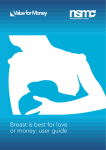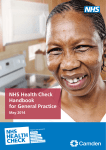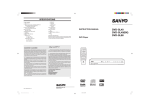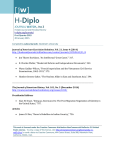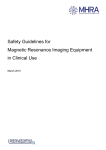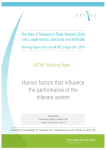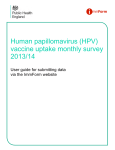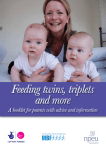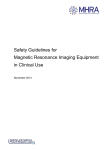Download Tell them about alcohol for love or money: user guide
Transcript
Tell them about alcohol for love or money: user guide About The NSMC We are The NSMC, the international centre of behaviour change expertise. We’re dedicated to making change happen that improves people’s lives. We do this by supporting organisations to design cost-effective programmes that help people adopt and sustain positive behaviours – those that improve their lives. Eating healthily, being more active and saving energy are just some of the positive changes we have helped our clients achieve. As well as programme support and strategic advice, we also provide professionals with the skills and resources to design and deliver their own cost-effective behaviour change programmes. Originally set up by the UK Government, we now have a global reach, applying social marketing skills, knowledge and experience from around the world to solve behavioural challenges. www.thensmc.com 1 Contents 1 Introduction 3 Using the tool 10 Interpreting the results 18 Other pages of the tool 20 Acknowledgements 21 References THE NSMC TELL THEM ABOUT ALCOHOL FOR LOVE OR MONEY i Introduction The NSMC has worked with leading health economists and NICE to develop a suite of online Value for Money tools. These will help practitioners and commissioners to calculate the value for money of their social marketing and behaviour change programmes. The alcohol intervention tool is one of those developed. 1 The tools have two important uses: 1. To help plan for proposed social marketing and behaviour change programmes by estimating the likelihood that they will provide value for money 2. To evaluate whether social marketing and behaviour change interventions were value for money upon completion. The tools go beyond costs to the NHS, to include wider societal costs THE NSMC TELL THEM ABOUT ALCOHOL FOR LOVE OR MONEY Using the tool These guidelines are intended both to help users and to provide a background on the development of the tool. You may also wish to refer to the Glossary and NICE Intervention Costing Guidelines available on The NSMC’s website. Most users may choose only to use the Data Input and Results pages, but advanced users can also make use of other pages to update the tool as further evidence becomes available. The tool is intended to help you evaluate the Value for Money (VfM) of interventions to support the delivery of various forms of screening, brief intervention and follow-up for people in danger of falling into alcohol abuse. It is also intended to apply to early stages of alcohol harm reduction, when the person concerned is capable of controlling their choices. It is not relevant to more advanced cases of alcohol dependency. This tool is intended to support other guidance and advice in this field rather than to replace it. It builds on benchmark studies identified by the NICE team and from expert studies from many different sources. In some fields, such as long-term behavioural outcomes, impact on social care, employers and crime, the data is inconclusive. However, as it is unacceptable to leave local teams with no method of assessing cost-effectiveness, a set of reasonable assumptions are proposed in this tool as a starting point. As John Maynard Keynes said: ‘It is better to be roughly right than precisely wrong!’ These data should be improved and updated by experts as we learn more about this subject. The tool shows a range of values reflecting uncertainty in estimates of achieving behaviour change by examining the impact of up to ten per cent more or less favourable assumptions about behaviour following quitting. It does not reflect the underlying uncertainty of health gain or NHS cost estimates or health outcomes. These are treated as consensus value to be agreed by experts. You can repeat the evaluation for a range of data to reflect these uncertainties in a sensitivity analysis around the central case. In all cases, it is more appropriate to report a range of possible values than to give an overly-precise single estimate. Data input Completing the data input sheet The following section provides details of what data should be included in each section of the tool, and also what evidence has been used in its development. Intervention costs The tool can be used to evaluate costs and outcomes over one year or over a shorter period. For longer-term projects it will allocate one- off planning and start up costs over the lifetime of the intervention project. Detailed advice on what costs should be included is provided in the NICE costing guidelines, available on The NSMC website (www.thensmc.com/resources/vfm/guidelines). Below are further details of what should be included in each field. 1. In Table 1 please enter the: a) Cost of planning and developing the intervention The separation between intervention and NHS costs assumes that behaviour change support may be funded by a PCT, Clinical Commissioning Group or Local Authority separately from the provision of services, such as brief interventions and follow up for people at risk. Furthermore, aspects of the intervention might be funded by employers or give rise to costs to clients. THE NSMC TELL THEM ABOUT ALCOHOL FOR LOVE OR MONEY 2 However, throughout this analysis all costs are mutually exclusive so please avoid any doublecounting except for incentives or rewards which are both a cost to the intervention and a negative cost (such as a payment) to clients. Development and capital costs should include those relating to the design and application of a specific behaviour change project for target clients. General needs assessment, such as a JSNA, should be excluded. However, research conducted during the scoping phase for the specific project should be included. b) Annual revenue costs per year of supporting the intervention This should include management, monitoring and other commissioner operating expenses. If the project or elements of it are contracted to private sector providers, VAT should be excluded (as these are transfer payments to government). Full public sector staff costs should be included, but not unavoidable overheads, e.g. management and premises costs that are not changed by the project. 2. In the field entitled ‘What are the…’ (Table 1), the following costs should be considered and included when relevant: a) NHS set up costs including capital, training, and reorganisation Capital or other one-off set-up costs, such as retraining and reorganising staff and services, will be spread over the life of the project. b) NHS annual revenue costs per year Annual costs include additional staff time required for the delivery of the intervention (e.g. time spent assessing clients’ risk of alcohol harm, delivering ‘brief interventions’ and any follow up support). Costs of supplies may include leaflets and other materials for additional clients. The cost of premises and/or equipment should be included only if they are specific to the project and 3 THE NSMC TELL THEM ABOUT ALCOHOL FOR LOVE OR MONEY would otherwise not be required or if they are in such high demand that other valuable activities must be curtailed. Treatment costs for alcohol related conditions will be estimated by the tool and therefore do not need to be separately estimated. 3. Add in any other public sector costs, if relevant: a) Project development and capital expenditure If implementation of the intervention gives rise to costs for other public sector services, the costs incurred by social workers, teachers, police, etc. may be relevant. Capital and set-up costs, such as specialised training, should be included here. The tool will apply estimates of the long term impact on social care, police and other criminal justice services as well as the NHS. b) Annual revenue costs per year Annual costs to other public sector services should be included here if relevant. However, it is important to consider only additional costs above those already incurred by such services in the normal course of their work. 4. Charges, costs or incentive payments to clients (if relevant) If clients (people with alcohol problems) pay for items such as diaries or support group meetings, the aggregate annual cost should be recorded here. Payments to clients as a reward or incentive should be included as both an element of project cost and as a payment to clients (these are transfer costs). The incentives paid should be entered here as a negative cost, representing total payments received by all clients per year. 5. Employer or other partner costs (if relevant) a) Project development and capital expenditure If employers (or partners such as supermarkets or food producers) contribute to the cost of an intervention, this should be recorded as a social cost and this may reduce the public sector intervention costs. In this box, enter any capital or start-up costs to employers. b) Annual revenue costs per year Annual costs to employers or other partners should be entered here. 6. Over how many years should development and training costs be spread? Capital costs and project development costs will be spread over the life of the intervention project. These are assumed to be at the base year price level. This should be the same year as the year for which outcome results are reported. If this is not the case (e.g. the development and training costs relate to an earlier year), then they should be inflated to the same price level. All other outcomes and savings will be automatically discounted or inflated to this base year level, which should be entered below. One problem for interventions that involve training health professionals to deliver brief alcohol harm interventions is that the rate at which they deliver advice often falls off after the first year. Thus, it is important to establish a realistic estimate of the rate of delivery of brief interventions over the course of the intervention project. Table 2: Clients and Outcomes Enter information on the number and characteristics of clients and outcomes planned or achieved. The tool can be used to assess planned interventions or to evaluate current projects. 1) Enter the total number of clients per year (i.e. people at risk of alcohol harm contacted) This should include all relevant targeted people contacted by the behaviour change intervention, not just those who change their behaviour. This may also include multiplier-effects (e.g. where one contact also influences the behaviour of family and friends). However, please note the warning below. THE NSMC TELL THEM ABOUT ALCOHOL FOR LOVE OR MONEY 4 “The percentage of people achieving the behaviour change indicator may be increased if a family or community multiplier can be shown” 2) Impact on the shift from heavy to moderate drinking after one year? The percentage of people achieving the behaviour change indicator may be increased if a family or community multiplier can be shown (e.g. if those initially contacted have encouraged others to moderate their drinking). However, it seems that reported influence on others is very unreliable, so clear evidence of this impact (such as attendance at an alcohol advice service) would be desirable. The behaviour change indicator suggested is the percentage shift from heavy to moderate drinking. There are of course several different ways of measuring this shift. One is by using the Alcohol Use Disorders Tests (AUDIT) which asks eight simple questions as follows: 5 THE NSMC TELL THEM ABOUT ALCOHOL FOR LOVE OR MONEY AUDIT test Looking back over the last year: 1. How often do you have a drink containing alcohol? (0) never (1) monthly or less (2) 2-4 times/month (3) 2-3 times/week (4) 4 or more times/week 2. How many drinks containing alcohol do you have on a typical day when you are drinking? (0) 1-2 (1) 3-4 (2) 5-6 (3) 7-9 (4) 10 or more 3. How often do you have 6 or more drinks on one occasion? (0) never (1) less than monthly (2) monthly (3) weekly (4) daily/almost daily 4. How often during the last year have you found that you were not able to stop drinking once you had started? (0) never (1) less than monthly (2) monthly (3) weekly (4) daily/almost daily 5. How often during the last year have you failed to do what was normally expected from you because of drinking? (0) never (1) less than monthly (2) monthly (3) weekly (4) daily or almost daily 6. How often during the last year have you needed a first drink in the morning to get yourself going after a heavy drinking session? (0) never (1) less than monthly (2) monthly (3) weekly (4) daily or almost daily 7. How often during the last year have you had a feeling of guilt or remorse after drinking? (0) never (1) less than monthly (2) monthly (3) weekly (4) daily/almost daily 8. How often during the last year have you been unable to remember what happened the night before because you had been drinking? (0) never (1) less than monthly (2) monthly (3) weekly (4) daily/almost daily Scoring responses as shown generates the following categories: • Under 8: Low-Risk Drinker • 8-20: At-Risk or Problem Drinker • 20+: Likely Alcohol Dependent THE NSMC TELL THEM ABOUT ALCOHOL FOR LOVE OR MONEY 6 follow-up call from a clinic nurse two weeks after each GP meeting. Behaviour change can be indicated by the percentage moving from eight to 20 to below eight in this scoring. Other measures may use different tests or indicators of safe level of drinking, e.g. the numbers of men drinking less than 21 units and women drinking less than 14 units per week. Cases 1-4 If you do not know or cannot estimate the likely impact on behaviour change of your alcohol harm reduction intervention, a series of benchmark studies have been identified by NICE. These demonstrate typical values achieved by the delivery of various forms of screening, brief intervention and follow up. If your intervention is similar to one of these, you can simply select the type of intervention and see what VfM would be achieved if your project were similarly successful. • Case 1: A&E intervention The patient is screened with a FAST3 test when next attending a major or single specialty A&E department, walk-in centre or minor injuries unit. The brief intervention is offered as a separate appointment on a day subsequent to the screening. This is assumed to be delivered by an alcohol specialist nurse for a duration of 25 minutes. Effect: 1.4 per cent behaviour change from heavy to moderate drinking (NICE guidance) • Case 2: Primary care intervention Physician advice in general practice regarding problem drinking. The intervention involved receiving: o A booklet o A workbook of current health behaviour o A review of prevalence of problem drinking o A list of adverse effects of alcohol o A worksheet on drinking cues o A drinking agreement (prescription and drinking diary cards) The intervention consisted of two 15 minute appointments a month apart. Patients received a 7 Effect: 7.6 per cent behaviour change from heavy to moderate drinking (HELP tool) • Case 3: Primary care intervention Screening and brief intervention by a practice nurse at GP registration (five min). Effect: 0.5 per cent behaviour change from heavy to moderate drinking (HELP Tool) • Case 4: Your intervention You can estimate the impact on behaviour change arising from your intervention. This should include estimates of the initial take-up of advice, e.g. how many clients initiate change and persistence after one year. For example, you may find that 30 per cent of clients initially say they will modify their behaviour, but perhaps only 15 per cent of these will actually continue to modify their drinking after one year. This will give a long term shift of 4.5 per cent (30% x 15%) at the end of a year. Experience suggests that the length and intensity of the initial intervention may be less importance than the provision of follow up and support 3) Percentage of clients in the most disadvantaged 20% This provides a measure of the extent to which disadvantaged people are addressed. If there is no bias towards disadvantage, 20 per cent of respondents would be expected to be in this category. Disadvantage may be measured by the Index of Multiple Deprivation (IMD) scores (see Glossary) or other ways determined locally. 4) Baseline comparator of how many interventions were being delivered in prior year If the project increases the number of brief alcohol THE NSMC TELL THEM ABOUT ALCOHOL FOR LOVE OR MONEY harm interventions being delivered from a previously achieved level, please enter the number of interventions delivered before the current intervention. This is only relevant if the costs only apply to the increased number of brief interventions. 3) Which mode of intervention is most like the one you are supporting? Either select one case most similar to your intervention or select Case 4 and fill in the estimated impact on percentage behaviour change shift from heavy to moderate drinking. 6) What year’s prices are you using? (Known as the base year for the analysis.) Generally, this should be the year of the intervention for which you have outcome data. You have to input costs in terms of that year’s prices so you may have to adjust for inflation between the year in which the intervention was planned and developed and the base year of the intervention. This is included to prevent the tool from becoming out of date. 7) Enter your weight for disadvantage (optional) This allows you to give an extra value to impacts on disadvantaged and hard-to-reach groups. A value between 0 and 100 per cent can be used (but enter ‘0’ if you do not wish to apply a weight) giving that percentage more value to interventions for disadvantaged people. The tool does this by simply adding an extra value to the percentage of clients in the most disadvantaged 20 per cent using IMD scores or in some other way you may define. For example, this means that if you chose a weight of 50 per cent and all the clients were in the most disadvantaged group, a value of the outcomes will be shown as 50 per cent more than the outcomes for a project which did not address disadvantaged people. However, while this value is shown in the results page, it does not affect the main outcomes reported which are not weighted. THE NSMC TELL THEM ABOUT ALCOHOL FOR LOVE OR MONEY 8 Giving an extra weight or ‘utility value’ to disadvantage is controversial. Department of Health (DH) policy is not to weight Quality Adjusted Life Years (QALYs) because everyone’s health is equally valuable. However, it could be argued that addressing disadvantage is an important priority, due to the widening health inequalities gap. The results will also show the effect of weighting for disadvantage and a priority score from the HELP programme. This project surveyed the way in which 99 public health professionals prioritised projects. It then developed a formula to model their values (Utility) as a preference curve based on cost effectiveness (Cost per QALY, C), the reach of the project (what proportion of the population could benefit, R) and impact on disadvantage (percent of clients in most disadvantaged 20 per cent, D). 7) Enter the Reach (optional) The ‘Reach’ of the project is a term used in the HELP system. To apply their measure of the value placed on addressing equity and the priority of this project, you need to include a value for Reach to represent the percentage of people who could be eligible for the intervention if it were extended nationwide. This might be all adult drinkers or it might refer to a specifically targeted group – for example, of pregnant women drinkers. You need to estimate what proportion of the population they make up. Some experts suggest that such weights and priority scores are not relevant to local decisions. For more information on the Health England Leading Prioritisation, visit: http://help. matrixknowledge.com This tool derives a weight for disadvantage by substituting values from the current project in this formula. It is also replicates the utility score that would be given by the HELP formula: Utility = e (-0.0000586x C + 0.0435987 x R + 0.119895x D) For a detailed explanation of this see: http://help. matrixknowledge.com You may choose to ignore these methods of weighting outcomes and to treat disadvantage as a separate issue as DH suggest. To do this, you may wish to make use of the Health Inequalities Intervention toolkit available from the London Health Observatory at www.lho.org.uk/LHO_Topics/Analytic_ Tools/HealthInequalitiesInterventionToolkit.aspx 8) Enter the percentage of people employed The percentage of people who are employed is used to generate estimates of benefits to local employers. It can also be used to explore the benefits to one employer engaged in a workplace alcohol harm reduction programme. For young clients, employment prospects rather than current employment can be used to generate lifetime employment benefits 9 THE NSMC TELL THEM ABOUT ALCOHOL FOR LOVE OR MONEY Interpreting the results The results page reports a wide range of outcome measures that were requested by various local and national users during the piloting of these tools. You need to choose which measures of Value for Money are most relevant, taking into account the priorities of decision-makers and the strength of the available evidence which varies for different outcomes. Sensitivity analysis In general, it is more reasonable to report a range of possible outcomes rather than just reporting a single central estimate. The sensitivity analysis shows a high and low value range arising from different assumptions about the behaviour change shift from heavy to moderate drinking. Sensitivity analysis in this tool does not consider the uncertainty in underlying estimates of health gain and costs, which are treated as consensus estimates. Users can also vary the input data and other factors to generate other sensitivity analyses and to examine ‘what if?’ questions. Table 1: Net Local Public Sector Cost per Lifetime Health Gain “You need to choose which measures of Value for Money are most relevant” Health impact The value shown represents the estimated current value of the lifetime reduction in health risk arising from the project. This is based on the attributable health burden due to alcohol misuse taken from the WHO National Burden of Disease Tool of 2009 applied to the UK and then adjusted for England (this was provided by NICE and WHO). This uses UK health outcome figures and Population Attributable Fractions (how much of each outcome is due to each cause) for High Income countries in the European Region in 2004. The Burden of Disease Tool measures impacts in terms of Disability Adjusted Life Years (DALYs) THE NSMC TELL THEM ABOUT ALCOHOL FOR LOVE OR MONEY 10 Years of Life Lost (YLL) and Years Lived with Disability weighted for disability (YLD) and Deaths (see Glossary). Estimates of total UK DALYs are derive from Green and Miles (2007)1. Data generated by this tool has been matched to the data generated by benchmark studies, so that the health impact in QALYs generated by the tool matches the outcomes reported by the benchmark studies. It is important to note that the model estimates health impacts in terms of lifetime health risks. It is not possible to provide a timescale for resulting impacts on health or costs, but because these factors are discounted to the base year, the equivalent health impact and cost burden can be estimated. QALYs impacts QALYs are the most commonly used measure of health gain in the UK. Outcomes are reported in these terms by converting from Disability Life Years (DALYs) to QALYs using a conversion factor of 1/0.754 assuming disease onset at the age of 65 and duration of five years. This is taken from Sassi (2006)2. While not perfect, this is the best available estimate. Further research could improve this conversion factor. Net cost to the public sector This is simply the summary of public sector costs per, year shown in the data page, resulting from the costs you have reported. Cost per QALY This is derived by dividing QALY gain by public sector cost. This is shown as a central estimate and high and low values. Cost Savings to the NHS Potential costs savings per person at risk per year are derived by dividing the total cost of alcohol related harm to the NHS (taken from the Department of Health (2008) The cost of alcohol harm to the NHS in England: An update to the Cabinet Office (2003) study updated to 2007/2008 values) by the number of people at risk in 1993. The 1998 Health Survey for England identified 21 per cent of adults (27 per cent men and 14 per cent women), who drank more than the 21 units for men and 14 units for women. By 2007, 24 per cent of adults (33 per cent of men and 16 per cent of women) were defined as at risk of alcohol abuse. This is indicated by an Alcohol Use Disorder Identification Test (AUDIT) score of eight or more and four per cent of people at risk of major harm with a score of 16 or more. Using an estimate from 15 years ago provides a better way of relating current health outcomes to their cause because most alcohol related health outcomes result from 20 to 30 years of alcohol misuse (though other impacts such as crime are related to current consumption). This provides an estimate of the cost to the NHS per alcohol misuse year. NHS expenditure estimates have been increased in line with House of Commons Library Standard Note SN/SG/724 NHS Funding and Expenditure 12 January 2011 by Rachael Harker. It is recognised that these are broad cost estimates that need to be improved but these figures at least provide a starting point for assessing overall cost impacts. Cost Savings to Local Authorities and other Local Services These include police and criminal justice costs and adult social care and wellbeing costs. Police and Criminal Justice Service Costs Estimates are based on the 2003 Cabinet Office paper, Alcohol misuse: How much does it cost?, updated for more recent cost of crime figures (Dubourg and Hamed 2005, The economic and social costs of crime against individuals and households 2003/04, Home 11 THE NSMC TELL THEM ABOUT ALCOHOL FOR LOVE OR MONEY Office) and adjusted for England in 2007/2008. This produces a total of £77 billion, of which 15 per cent are alcohol-related, suggesting costs of £1.156 billion. Drink driving offences are separately estimated at £625 million, giving a total of £1.78 billion in 2007/2008 expenditure levels. These are inflated at the rate assumed for LA services = four per cent p.a. In considering the impact of reduced alcohol abuse, the tool also takes into consideration the long run marginal cost impact, i.e. how much long run costs might be reduced by a lower incidence of alcohol abuse. As an indicative starting point, this has been set at 85 per cent (which could be changed if better data becomes available). Adult social care and wellbeing Cost savings are estimated on the basis that these costs will vary with Years Lived with Disability weighted for disability. This is a reasonable basis for estimation but there has been insufficient research evidence to support the current estimate. National Statistics for the Department of Communities and Local Government report total expenditure on Social Care in England for 2008/2009 was £20.1 billion. Of this, some £7.2 billion relates to adult social care and other adult services for adults with health related problems. Because long-term costs relate closely to the number of people requiring support but may also involve long-term fixed costs, 85 per cent of the costs (the long run marginal costs) are taken into account in estimating potential savings. These savings are allocated on the basis of weighted years lived with disability. This probably underestimates the total cost of social care and welfare for children associated with alcohol abuse. QALY Outcome per additional brief intervention This shows the health risk reduction for each additional person receiving a brief intervention. THE NSMC TELL THEM ABOUT ALCOHOL FOR LOVE OR MONEY 12 For the three benchmark studies, the outcome will match the outcome reported by the studies (there may be very slight differences due to rounding errors). Thus the outcomes will match the available data. While these may not themselves be entirely reliable, they are the best available data. Total Years of Life Added This is taken from the WHO National Burden of Disease Tool provides a more reasonable measure of value. If this figure is divided by deaths it shows the average loss of years of life (in this case about 11.5 years). Total Hospital Admissions Averted As this is a key Public Service Agreement Target, an estimate of this impact is included based on the level of alcohol related hospital admissions in 2007/2008. This is taken from Local Alcohol Profiles for England in relation to levels of alcohol misuse in 1993. Total Years Lived with Disability Weighted for disability, also taken from the WHO National Burden of Disease Tool, provides an indication of health and care needs that can be reduced by alcohol harm reduction. It is notable that alcohol related admissions have risen by about 15 per cent since that time. It may therefore be helpful to update this estimate to reflect the balance between admissions resulting from long-term misuse and those resulting from recent changes in behaviour. Total Deaths Averted The tool also estimates the total numbers of deaths averted as a result of the intervention, based on figures from the 2003 Cabinet Office Paper, Alcohol misuse: How much does it cost? This gives a value for deaths attributable to alcohol of between 14,400 and 20,700 for England and includes deaths ‘partially attributable to alcohol’. An average of these figures is used here. It is notable that the deaths reported by this paper are much higher than those reported in National Statistics on morbidity, which identify deaths arising solely from alcohol disorders as less than half this total. While the overall impact on health risks and likely future outcomes and costs can be assessed, it is not possible to estimate when these will occur with any accuracy. Alcohol appears to result in earlier death than obesity or smoking but it may still be expected that most deaths will occur after the age of 65. Numbers Needed to Treat, to avert death or hospital admission This is a measure used in primary care to assess the effectiveness of interventions, such as treatment with Statins. In this case, it has been applied to provide a measure of the number of people who would need to be contacted in order to avert one alcohol-related death or hospital admission. Table 2a: Societal Impacts: Lifetime Benefits to Clients The benefits to clients (we use this term in preference to patients, since they may not be ill, or targets, which makes them sound like victims) include: less expenditure on alcohol, reduced informal care and employment impacts. For the wider public, there are benefits arising from reductions in the social cost of crime. In order to estimate the impact of the intervention the relevant cost items are attributed to total alcohol outcomes, health risk, death or disability. The impact of the intervention on health outcomes is forecast for the remaining life of the client, assuming a life expectancy of 81 and a working life up to age 67. The estimated impact on each item is then discounted to the baseline year. Expenditure on alcohol The current Institute of Alcohol Studies Fact Sheet: Economic Costs and Benefits provides an estimate of household consumption on alcohol of £43.6 billion for England in 2007/2008 prices. 13 THE NSMC TELL THEM ABOUT ALCOHOL FOR LOVE OR MONEY It is estimated that 25 per cent of this may relate to alcohol misuse. This is divided by the 2007 estimate of people at risk of alcohol harm to derive an estimate of the cost per person at risk. This may give an underestimate of the additional cost of alcohol consumption for heavy drinkers as compared to moderate drinkers, as it appears that heavy drinkers may consume much more than moderate drinkers on average. However, as the target clients are people who are beginning to drink too much rather than the heaviest drinkers, this is a reasonable estimate. Reduced Informal Care The highest costs of care are incurred by families and other informal carers. An estimate of the total extent of care is provided by Buckner and Yeandle (2007)3 and University of Leeds. “For the wider public, there are benefits arising from reductions in the social cost of crime” While this analysis is based on the cost of replacing informal carers with paid staff, in this case the value used is based on the hours of informal care worked in England valued at a leisure time rate of £5.50 per hour in 2007 terms. This has then been inflated to current values. It is reasonable to assume these costs are reduced in proportion to the reduction in Years Lived with Disability (YLD) weighted for disability as estimated by the tool. There is no more detailed research evidence available. Employment Income and Pension Less Benefits and Tax The 2003 Cabinet Office paper Alcohol misuse: How much does it cost? suggests that Years of Life Lost (YLL) before the age of 65 may amount to 42 per cent of the total. It values lost employment at the median wage of £25,250 with an effective tax rate of 12.5 per cent in 2007/2008 and an employment rate of 70 per cent. This suggests a total cost of £1.3 billion. This leaves 52 per cent of YLL giving rise to a loss of pension at £5,000 per year in 2007/2008 values = £0.58 billion resulting in a total loss of £1.88 billion. This can be allocated by YLL. THE NSMC TELL THEM ABOUT ALCOHOL FOR LOVE OR MONEY 14 In addition, people with alcohol problems are more likely to be unemployed. The same Cabinet Office paper reports that the cost of lost employment to heavy drinkers was some £2.2 billion in 2002 values or £2.6 billion in 2007/2008 values. Loss of earnings and pension may be offset by sickness and incapacity benefits payments which can be estimated from Dame Carol Black’s 2008 report Working for a Healthier Tomorrow, which estimates the total cost of sickness benefits at £29 billion allocated to YLD weighted for disability, giving a total of £2.6 billion related to alcohol misuse. These broad estimates suggest a net a total cost to heavy drinkers of £1.88 billion per year in 2007/2008 values. Costs to Clients This is simply taken from the data input page and shows costs incurred by clients or the incentive provided (this would be a negative cost). If there are specific costs to or incentives for clients these only apply during the intervention. Cost of Crime Other than Criminal Justice Costs This impact was estimated using a methodology introduced by Brand and Price (2000) and updated by Dubourg and Hamed (2005)4 and adjusted for England in 2007/2008. This provides an estimate of the economic cost of crime excluding CJS costs of £31 billion (see previous item) for England in 2007/2008 values of which 15 per cent may be alcohol related = £4.65 billion. It includes intangible costs of fear and distrust. This social cost is added to the costs arising from the Human Value of a QALY, since they are similar but not overlapping. Table 2b: Societal Impacts: Working Life Benefits to Employers Benefits to employers include reduced absenteeism and improved productivity at work, less any costs incurred in supporting the alcohol intervention. Reduced Absenteeism The estimated cost to employers of absence due to alcohol misuse quoted by Alcohol misuse: How much does it cost? adjusted for 2007/2008 values is between £1.25 and £1.85 billion. The impact of reduction in alcohol harm is only considered up to the assumed end of working life at 67. Improved Productivity The cost of lost productivity at work due to alcohol misuse at the workplace (or the night before) is variously estimated, but it seems generally agreed that this is at least equal to absenteeism costs. As a starting point, mid range estimates are used above. More specific estimates should be made for each workplace. The period of impact has been reduced to reflect remaining working life assuming this lasts till the client is 67. The loss of productivity due to people being sick or unfit at work is contentious. Some American research suggests it may be higher than absence costs. The net impact on employers will depend on the situation. Tax Effects Benefits have been reduced to reflect an effective corporate tax rate of ten per cent. Table 2c: Societal Impacts: Lifetime Impacts on Government and Public Sector Costs Impacts on Government include reduced excise duty and VAT, reduced sickness payments, increased pension payments less tax and any increase or decrease in NHS, Local Authority or other public sector cost. Excise Duty and VAT As reported by the Institute for Alcohol Studies 2008, Alcohol Tax, Price and Public Health for 2004/2005. It has been adjusted for England and increased in line with income inflation to a 2007/2008 value of £13.25 billion, a move from heavy to moderate alcohol use is assumed to reduce this by 25 per cent. 15 THE NSMC TELL THEM ABOUT ALCOHOL FOR LOVE OR MONEY Sickness and Disability Benefits These are taken from Working for a Healthier Tomorrow which estimates the total cost of sickness benefits at £29 billion allocated according to YLD weighted for disability. Increased tax income less additional pension payments Tax income is estimated on the basis of Alcohol misuse: How much does it cost?, which suggests that years of life lost before the age of 65 may amount to 42 per cent of total YLL, valuing lost employment at the median wage of £25,250 with an effective tax rate of 12.5 per cent in 2007/2008. Pension payment impacts are based on years of life lost assuming 58 per cent are pensionable years and state pensions of £5,000 per annum, plus corporate tax income at an effective rate of ten per cent. Table 2d: Societal Impacts: in terms of the Human Value of QALY gain The Human value of a QALY This table applies a social value to the improvement in health risks for mothers and babies gained as a result of the intervention. This can be regarded as the cost of pain and grief caused by death and illness. In discussion with Robert Anderson, Economic Adviser to Department of Health in 2011, it has been pointed out that the Department of Health’s official position is that a QALY can be valued at £60,000 as derived from Department of Transport willingness to pay survey of 1991/0992 (Highways Economics Note 1) in respect of fatal accidents updated to 2007 values. However, as NHS expenditure is limited, it is accepted that the marginal productivity of the NHS is four QALYs per £100,000. For this reason, a value of £25,000 can be applied. While the Department of Health continue to refer to a survey carried out in 1991/1992 for the Department THE NSMC TELL THEM ABOUT ALCOHOL FOR LOVE OR MONEY 16 of Transport, it should be noted that this willingness to pay survey focused on traffic accident outcomes. These include early death, which has a particular emotional value. “The tool permits you to add an extra value to the percentage of clients in the most disadvantaged 20 per cent” Another estimate of the value of a QALY gain can be based on the upper estimate of the value placed on non-fatal injury derived from the same survey, which gives an estimate of £27,000. This is close to the figure used by NICE of £30,000. Thus for this purpose, a value of £25,000 in 2007/2008 has been used, updated for inflation in incomes but this can be varied if required. Weighting for Disadvantage, Your Weights or Health England Leading Prioritisation (HELP) The tool permits you to add an extra value to the percentage of clients in the most disadvantaged 20 per cent using IMD scores or in some other way you may define, or to apply a weight derived from the HELP project (see Data input section of this guide). It also provides a HELP utility score. Table 2e: Societal Impact: Social Return on Investment The calculation of Social Return on Investment (SROI) does not take into consideration any weighting applied to QALYs as above. The SROI is expressed as a number. 1 would mean a social value of £1 for every £1 spent by all stakeholders. SROI is calculated in two ways: as the impact on all stakeholders divided by the total cost to stakeholders; and as the value of the QALYs increased by the intervention valued at £25,000 in 2007. For more details of the SROI approach, see the Glossary and related links from The NSMC website. 17 THE NSMC TELL THEM ABOUT ALCOHOL FOR LOVE OR MONEY Other pages of the tool The other pages of the tool can be explored by users but these are basically working sheets. All references have been referred to in the Data input and Results sections of this guide. Impacts The Impacts page of the tool provides a mechanism for projecting future alcohol behaviour and the resulting impact on health and other outcomes over the life of the clients. It also provides high and low scenarios based on changes in behaviour outcomes. The variable in this part of the tool can be changed at the data entry page or by a more detailed updating of the tool. We suggest this only for advanced users. To ensure that the impacts match the benchmark studies, the behaviour change is assumed to be measured at the end of the first year and the level of persistence from years two to ten has been set at 90 per cent. It is assumed that clients instantly recover a normal health status and the age of the clients is assumed to be 32. This produces the same level of QALY gain as indicated by the studies. However, in comparison with other experience it might be considered that these assumptions are rather optimistic leading to particularly high levels of VfM. Such assumptions should be reviewed by an expert panel to examine the evidence from other studies and from experienced practitioners, to establish a consensus on these assumptions and hence the reliability of the benchmark studies. It also provides estimates of YLD, YLL and deaths and includes estimates of alcohol behaviour in 1993 and 2008, NHS, Local Authority and Criminal Justice System costs. While this page can be updated, we suggest this should be done by advanced users as further evidence becomes available. Social The Social page provides the detailed working necessary to generate social impacts. It includes an analysis of the cost savings to alcohol users in undiscounted terms and also an evaluation of the additional cost to the NHS of averting early deaths. However, for ethical reasons and because such estimates are not brought into other evaluations, it has not been applied in the results page. Look Up Tables This page provides details of the inflation factors and discount rates used in the tool. It can be updated but it is suggested that this should only be attempted by advanced users. Inflation estimates for NHS costs are taken from official projections, wage inflation is assumed to be four per cent and the social discount rate is set at 3.5 per cent. These factors can all be adjusted. Other Sources of Help and Guidance This tool is intended to support evaluation alongside the application of qualitative guidance. It also attempts to translate the consensus on the costs and benefits of alcohol harm reduction programmes developed by experts into useable mechanisms. These will help local social marketing teams evaluate support programmes that encourage better long term outcomes. Current guidance includes: National Data The National Data page is based on the WHO National Burden of Disease Tool. It provides estimates of the impacts of alcohol misuse in terms of Disability Adjusted Life Years which are later translated into QALYs using the table from Franco Sassi. • Department of Health 2011 Alcohol Harm Reduction National Support Team: Engage, Recommend, Facilitate. Supporting Partnerships to Reduce Alcohol Harm: Key Findings, Recommendations and Case Studies, Local THE NSMC TELL THEM ABOUT ALCOHOL FOR LOVE OR MONEY 18 • • • • Stop Smoking Services, Service Delivery and Monitoring available at www.dh.gov.uk/en/Publicationsandstatistics/ Publications/PublicationsPolicyAndGuidance/ DH_125452 NICE 2010 guidance Alcohol Use Disorders: preventing Harmful Drinking available at www.nice.org.uk/PH24 Alcohol Learning Centre - an excellent source of guidance and practical tools including a guide to evaluation of social marketing in this field produced withThe NSMC and COI, available at www.alcohollearningcentre.org.uk Local Government Improvement and Development 2008 (Updated from renewal.net) Alcohol Misuse: a Community Systems Approach – solving the problem available at www.idea.gov.uk/idk/core/page. do?pageId=8234924 LAPE 2011 – Local Alcohol Profiles for England - Northwest Public Health Observatory available at www.nwph.net/alcohol/lape/index.htm There are a great many more sources of excellent research and guidance on aspects of alcohol harm reduction. There are also other ‘ready reckoner’ terventions to achieve alcohol harm reduction. The tool presented here shows how different approaches to assessing VfM in alcohol harm reduction and different measures of impacts can be applied. Some of these measures are contentious and rely on incomplete evidence. It is left to experts in the field and to local users to agree on how and when to use the different aspects of the tool and to continue to develop and improve the evidence base for such evaluations. It is hoped that the many experts and practitioners in this field will be able to build a clear consensus view of the full social and economic benefits of alcohol harm reduction and the means of measuring its VfM. 19 THE NSMC TELL THEM ABOUT ALCOHOL FOR LOVE OR MONEY Acknowledgements This guide was written by Dr Graham Lister, an Associate of The NSMC. The NSMC and Dr Lister would also like to thank the Project Advisory Board, the NICE team who provided cost data and identified benchmark studies, the WHO team who adapted the National Burden of Disease Tool for the UK, the National Alcohol Harm Reduction Team, who provided very helpful feedback on an early prototype, the Rechord team who worked on the presentation of the tool, the team from Matrix consulting who provided some of the data as well as quality assurance and the many local social marketing groups and experts who tried it out and suggested improvements. Any remaining errors and omissions remain the responsibility of the author. THE NSMC TELL THEM ABOUT ALCOHOL FOR LOVE OR MONEY 20 References 1. Green, S. and Miles, R. 2007 The Burden of Disease and Illness in the UK Oxford Healthcare Associates 2. Franco Sassi Calculating QALYs, comparing QALY and DALY calculations Health Policy and Planning. (2006) 21 (5): 402-408. 3. Buckner and Yeandle (2007) Valuing Carers –Calculating the cost of unpaid care Carers UK 4. Dubourg and Hamed 2005 The economic and social costs of crime against individuals and households 2003/04 Home Office 21 THE NSMC TELL THEM ABOUT ALCOHOL FOR LOVE OR MONEY Further support from The NSMC Practical advice and support If you need some fresh thinking to improve your results, we’ll carry out an expert review of your current approach to behaviour change. Practical recommendations on how to plan, manage, implement and evaluate your projects will ensure you’re able to make progress. Need help taking a behaviour change approach forward? We can develop a behaviour change strategy for your organisation – ensuring you’re better placed to deliver effective future programmes. We’ll support you through developing and managing your project, with mentoring offered as and when you need it. Using our ‘learning by doing’ approach, we bring our tried and tested behaviour change planning process to your behavioural challenge. To help make your project happen, we can also bring your stakeholders together and secure their involvement in achieving your objectives. Our tailored, interactive workshops, delivered by The NSMC’s expert behaviour change professionals, will explore how to take an audience-led approach to your challenge − using the latest thinking in behaviour change from your sector. Implementing an effective behaviour change project Whatever your behavioural www.thensmc.com challenge, our experts’ unrivalled experience in delivering behaviour change programmes will ensure it is addressed costeffectively. Our network of consultants and suppliers means the best specialists will take your project forward. Training and resources To give you and your team the skills you need to run your own behaviour change projects, we provide both classroom and e-learning training courses. Devised and delivered by expert professionals, they draw on real experience of what works. To help ensure your staff have the right tools and support when they need them, our online planning guide and toolbox provides everything they need to plan and implement a behaviour change programme. Tried and tested by a range of professionals and organisations, we can develop specialised versions, tailored to meet your organisational needs. Supporting your organisation to keep your audiences at the heart of everything you do We’ll help you develop and conduct research that will give you a firm foundation for a behaviour change intervention. Our experts will help ensure you get the most from your research budget. Our One Stop Shop database of unpublished market research gives you the means to quickly get to grips with your audience and behavioural challenge. It will enable you to focus your research and make the best use of your resources. If you’re pushed for time, our data synthesis service will package up the most relevant research into your challenge held on the One Stop Shop for you. Providing best practice in behaviour change ShowCase is our online case study database of behaviour change initiatives. From smoking to active travel, young people to health professionals, it highlights honest learning and success from the real world on a wide range of issues and audiences. You can follow the journey project teams took and find detailed information on the ‘how’ of delivering a behaviour change intervention. Capitalise on others’ achievements and learn from their mistakes and barriers, without having to commission expensive research. Independent evaluation We have specialist experience of evaluating behaviour change programmes of all kinds. We’ll help you demonstrate the impact of your projects to your stakeholders and capture lessons to improve future work We’ll also help you put together an evaluation plan that will ensure you collect the right information to effectively measure success and avoid knowledge gaps from the outset 2 Contact The NSMC Fleetbank House Salisbury Square London EC4Y 8JX T. 020 7799 7900 F. 020 7799 7901 www.thensmc.com Designed by Toby Hopwood



























